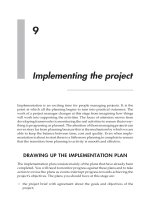Implementing the project
Bạn đang xem bản rút gọn của tài liệu. Xem và tải ngay bản đầy đủ của tài liệu tại đây (85.56 KB, 10 trang )
9
Implementing the project
Implementation is an exciting time for people managing projects. It is the
point at which all the planning begins to turn into practical outcomes. The
work of a project manager changes at this stage from imagining how things
will work into supporting the activities. The focus of attention moves from
developing frameworks to monitoring the real activities to ensure that every-
thing is progressing as planned. The attention of those managing projects can
never stray far from planning because this is the mechanism by which we are
able to keep the balance between time, cost and quality. Even when imple-
mentation is about to start there is a little more planning to complete to ensure
that the transition from planning to activity is smooth and effective.
DRAWING UP THE IMPLEMENTATION PLAN
The implementation plan consists mainly of the plans that have already been
completed. You will need to monitor progress against these plans and to take
action to revise the plans as events interrupt progress towards achieving the
project’s objectives. The plans you should have at this stage are:
࿖
the project brief with agreement about the goals and objectives of the
project;
࿖
a list of the deliverables;
࿖
agreement about how the project will be managed, reported and
reviewed;
࿖
the estimates and budget;
࿖
details of the people who will work on the project;
࿖
details of the accommodation, equipment and materials available;
࿖
the schedules, probably described in logic diagrams, Gantt charts and
critical path;
࿖
the risk and contingency plans.
You may not yet have an evaluation plan, although you should be clear about
how success will be measured. The evaluation plan can be considered at
review meetings. It is useful to think about it before the project progresses
too far, because you may want to collect data about performance and any
problems encountered as you go along rather than try to remember these
things much later.
To move from planning into action you will need to plan how action will
be taken and by whom. You will have to ensure that each task starts on time
and that the necessary resources are available when needed. The day-to-day
routines of the project will have to be managed, and monitoring will take
place throughout the implementation phase. There are a number of tech-
niques that can help managers of projects to monitor progress and to
control projects so that the balance of time, cost and quality is maintained.
As no two projects are alike, different approaches are necessary in different
circumstances.
TEAM STRUCTURE
Teams have great difficulty in working effectively if they are too large to work
together conveniently. Six to eight people is often considered to be about
right. If the project needs more staff in order to deliver all the outcomes, the
structure could consist of a number of teams, each with a team leader. The
team leaders would also form a team themselves to coordinate the project. In
some projects there may not be a team, but instead a number of individuals
or groups making a specialist contribution at an appropriate time. In either
case, the task of coordinating inputs is vital.
It is not necessary to name all the team members when structuring the
staffing for the project. It can be helpful to identify people in terms of the
108
Managing projects in human resources
expertise or skills that are needed to complete each of the main tasks. If there
is a need to recruit members to the team, this process will help to identify the
criteria for selection. If some of the project team have already been identified,
or if the team leaders have been appointed, there is an opportunity to include
them in determining the team structure. At this stage, the key responsibilities
can be allocated.
Example 9.1
Training the Trainers in Europe
A small training organization in the United Kingdom was approached
to take part in a project funded through the European Social Fund to
develop a ‘Training the Trainers’ programme to share and build on
good practice. Other partners included a charity with several centres
in Italy that provided a rehabilitation service for drug misusers, a local
government organization in Northern France, a charity that provided
a women’s refuge and work opportunities in Portugal and a rehabil-
itation centre for young offenders in Spain.
The project manager was based in France and visited all the partic-
ipants to develop the plan. The project team, consisting of trainers
from all of these countries, met for the first time in the United King-
dom to begin the implementation. It was at this point that it became
evident that many issues had not been considered. Although it had
been agreed that the team would work in English, many of the team
members could speak little or none of the language. Translators were
rapidly hired and discussions were able to start. It soon became clear
that some of these organizations had experience in training trainers
and others provided no formal training. In the workshop comparisons
were made of both formal and informal processes.
As the project progressed, team members became ‘experts’ in dif-
ferent aspects of training trainers, and experience was shared through
workshops in each of the participating countries, to involve a wider
number of local trainers. Team members developed portfolios to
demonstrate their competence in training trainers in their own coun-
tries, and each took the lead in presenting ideas and approaches from
their own context and country. The final report on this project was
developed through similar collaborative practice, drawing on the in-
dividual interests and strengths of team members.
Implementing the project
109
If the project is complex several people may need to hold responsibility for
supervising activities. Once the team structure has been agreed it should be
easier to decide who holds the different levels of authority. These will include
identifying who holds authority to approve release of resources and com-
pleted work, who must be consulted about what, and who must be informed.
In some projects it might be appropriate to allocate authority for recording
and storing information or for ensuring security.
The project manager will usually retain overall responsibility for ensuring
that the plans are carried out. Once the levels of authority have been decided
it is not difficult to decide how the approval will be sought and recorded,
how those who should be informed will be told and how consultation will
be arranged. All of these activities involve sub-tasks that can be allocated to
individual team members.
PLANNING TEAM RESPONSIBILITIES
It is important to give clear allocation of roles and responsibility for each task
and key stage. This ensures that each piece of work is ‘owned’ by a particular
person who will be accountable for completing it or seeking help if a problem
develops. Planning these responsibilities also helps to ensure that overall
responsibility for the work is spread appropriately between members of
the team.
It is also important to establish clear lines of accountability for each team
member. The arrangements will vary according to the size and complexity
of the project, but all those involved need to know:
࿖
what is expected of them, possibly written as objectives with timescales;
࿖
the extent of the authority they have to make decisions about their area
of work;
࿖
the person who will act as their line manager for the duration of the
project;
࿖
the arrangements and frequency for reporting and reviewing progress.
If the project is large enough to have team leaders for different activities, it is
important to check that each of these understands how the work of his or her
team fits into the overall plan. It can be helpful to give each team leader his
or her section of the plan detailing what should be achieved by specific dates.
The milestones identified earlier in the plans will provide a useful checklist
of outcomes and the dates by which each should be completed.
110
Managing projects in human resources
MAKING IT HAPPEN
It is often quite difficult to start work on a project. The focus changes from
planning to action. Even when tasks are allocated and the scheduling is com-
plete, staff will not automatically start working on the tasks. It is usually up
to the project manager as the leader of the project to ensure that work starts.
It is important to make sure that everyone knows who should carry out which
tasks, and when each should start. The staff must be free to begin work and
the essential materials and equipment need to be available. Even then, it is
often necessary to support staff to start the work.
It can be helpful to start with a meeting to ensure that everyone under-
stands the plan and where his or her contribution fits into the whole project.
Planning is often focused on timescales and schedules, and team members
may not be able to interpret the plans to find out exactly what they should
be doing. This is particularly true when plans have been computer generated
and look daunting to people who are not used to working with them.
Example 9.2
Understanding the plan
A new project manager had decided to hold a workshop to begin an
organizational change project because she thought it was important
to develop a shared understanding of how the project was intended
to progress. After the meeting she commented:
I had made a huge assumption. I thought that they all knew
about our organizational structure and strategy. There has been
so much information given out recently about the new strategic
direction. However, once I started making the introductory pre-
sentation I could see from their blank faces that they didn’t have
a clue what I was talking about. I had to change the workshop
plans completely and start from much further back than I’d
intended. I had to explain how the organization worked and
where we were going before they could begin to understand
what the project was about or why it mattered.
Once you are sure that everyone has sufficient understanding of the plans
you can start work. The key people responsible for carrying out each task
need to know exactly what is wanted, and you may have to confirm this with
each individual. In some settings it will be necessary to ensure that all the
formalities have been completed to secure the involvement of the team
Implementing the project
111









